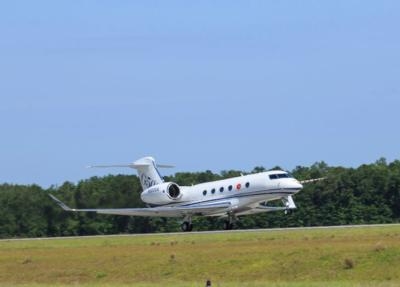Mon, May 18, 2015
Two-Hour And 16-Minute Flight Conducted For Evaluation Of Multiple Systems
There's another new business jet starting its flight test program. The all-new Gulfstream G500 successfully completed its first flight Monday.

The G500 took off at 10:39 a.m. May 18 from Savannah-Hilton Head International Airport, with Gulfstream experimental test pilots Scott Martin and Kevin Claffy at the controls. Flight Test engineer Bill Osborne provided on-board support.
The aircraft climbed to an initial altitude of 10,500 feet and reached a maximum altitude of 15,000 ft. During the 2-hour-and-16-minute flight, the crew exercised all primary flight control systems; evaluated handling qualities in takeoff and landing configurations; performed a simulated approach and go-around; and checked all systems using the Symmetry flight deck touchscreen controllers. The aircraft achieved a maximum air speed of 194 knots. It landed back in Savannah at 12:55 p.m. local time.
“The successful first flight of N500GA represents the tremendous investments we have made in the G500 program,” said Dan Nale, senior vice president, Programs, Engineering and Test, Gulfstream. “We have achieved this milestone thanks to Gulfstream’s world-class research and development teams and our commitment to setting new standards for business aviation.”
Years before this first flight, Gulfstream established four labs dedicated to the G500 program:
- A Conceptual Advanced Simulation Environment to develop fly-by-wire control laws and perform human factors evaluations
- A systems integration bench to integrate the avionics and aircraft systems with the aircraft’s Data Concentration Network
- A full flight deck integration test facility to evaluate major avionic and aircraft systems and software
- The ITF also includes an outfitted cabin to test the galley, the Gulfstream Cabin Management System and other interior elements
- And an iron bird — a spatially correct, dimensionally accurate structure, including the flight deck, used to rigorously evaluate the fly-by-wire flight controls, hydraulics, electrical systems and landing gear
- Before today’s flight, Gulfstream completed more than 34,000 hours of testing in the G500 labs on the ground before taking to the skies.
The G500 flight-test program consists of five aircraft, including a fully outfitted production aircraft that will allow the company to test all the interior elements and complete integration of the aircraft systems with the passenger experience.
The G500 is expected to receive type certification from the U.S. Federal Aviation Administration and European Aviation Safety Agency in 2017. It is slated to enter service in 2018.
(Image provided by Gulfstream)
More News
A Puff Of Smoke Came Out From The Top Of The Engine Cowling Followed By A Total Loss Of Engine Power On May 9, 2025, about 1020 mountain daylight time, an experimental amateur-buil>[...]
From 2022 (YouTube Edition): Jenny, I’ve Got Your Number... Among the magnificent antique aircraft on display at EAA’s AirVenture 2022 was a 1918 Curtiss Jenny painstak>[...]
Very High Frequency (VHF) The frequency band between 30 and 300 MHz. Portions of this band, 108 to 118 MHz, are used for certain NAVAIDs; 118 to 136 MHz are used for civil air/grou>[...]
“From approximately November 2021 through January 2022, Britton-Harr, acting on behalf of AeroVanti, entered into lease-purchase agreements for five Piaggio-manufactured airc>[...]
From 2008 (YouTube Edition): US Fish and Wildlife Service Chooses The Kodiak To Monitor Waterfowl Populations Waterfowl all over North America may soon have to get used to a new ab>[...]
 NTSB Prelim: Lee Aviation LLC JA30 SuperStol
NTSB Prelim: Lee Aviation LLC JA30 SuperStol Classic Aero-TV: Curtiss Jenny Build Wows AirVenture Crowds
Classic Aero-TV: Curtiss Jenny Build Wows AirVenture Crowds ANN's Daily Aero-Term (05.30.25): Very High Frequency (VHF)
ANN's Daily Aero-Term (05.30.25): Very High Frequency (VHF) Aero-News: Quote of the Day (05.30.25)
Aero-News: Quote of the Day (05.30.25) Classic Aero-TV: Quest Kodiak Enhances Migration Monitoring Programs
Classic Aero-TV: Quest Kodiak Enhances Migration Monitoring Programs



